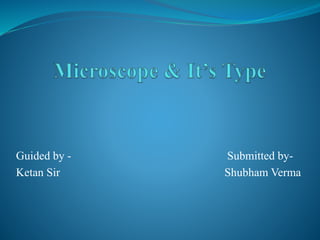
Microscope and its types
- 1. Guided by - Submitted by- Ketan Sir Shubham Verma
- 2. Introduction Microscope is an instrument used to see objects that are too small to be seen by the naked eye. Microscopy is the science of investigating small objects and structures using such an instrument. Microscopic means invisible to the eye unless aided by a microscope.
- 3. Types of Microscope Simple Microscope Compound Microscope
- 4. Simple Microscope A simple microscope is also called magnifying glass. It is actually a convex lens of small focal length , which is used for seeing the magnified images of small objects. A Simple microscope utilizes just a single lens for magnification.
- 5. Principle of Simple Microscope A simple microscope is used to obtain small magnifications. It is usually used for study of microscopic algae, fungi and biological specimen. Light from a light source (mirror) passes through a thin transparent object . A biconvex lens magnifies the size of the object to get an enlarged virtual image. The image is viewed from the other side.
- 6. Parts of simple Microscope Mechanical parts Optical parts
- 7. 2. Optical part- These parts are involved in passing the light through the object (specimen) and magnifying its size. The components of the optical parts are as follows- Mirror: A Plano-convex mirror is fitted below the stage to the vertical rod by means of a frame. It focuses the surrounding light on the object to be observed. Lens: A biconvex lens is fitted above the stage, to the vertical rod, by means of a frame. It magnifies the size of the object and the enlarged virtual image formed is observed by keeping the eye above it. For proper focusing, the lens can be moved up and down by the frame.
- 8. Compound Microscope Compound microscope is an optical instrument which is used to obtain high magnification. It is an extension of the magnifying glass which are used to see very small things. The magnifying power of a simple lens is very limited. It is difficult to get a magnification better than a few times without using a highly curved lens with a high refractive index This kind of lens will have a lot of aberrations that one can not see the image clearly. Therefore, we used two or more lenses which builds up the compound microscope.
- 10. Eyepiece: The lens the viewer looks through to see the specimen. The eyepiece usually contains a 10X or 15X power lens. Diopter Adjustment: Useful as a means to change focus on one eyepiece so as to correct for any difference in vision between your two eyes. Body tube (Head): The body tube connects the eyepiece to the objective lenses. Arm: The arm connects the body tube to the base of the microscope. Coarse adjustment: Brings the specimen into general focus. Fine adjustment: Fine tunes the focus and increases the detail of the specimen.
- 11. How does it works All of the parts of a microscope work together - The light from the illuminator passes through the aperture, through the slide, and through the objective lens, where the image of the specimen is magnified. The then magnified image continues up through the body tube of the microscope to the eyepiece, which further magnifies the image the viewer then sees. Learning to use and adjust your compound microscope is the next important step. It's also imperative to know and understand the best practices of cleaning your microscope.
- 12. THANK YOU
